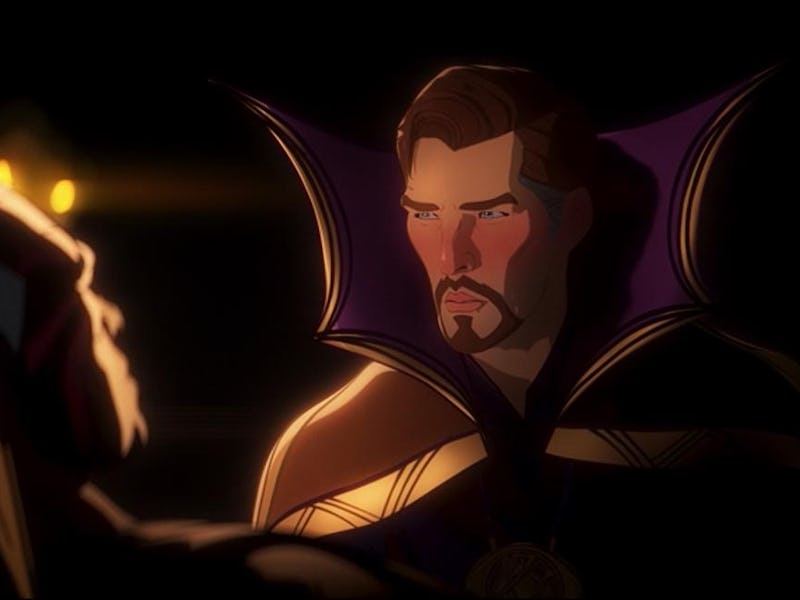What If...? Episode 4 fails to fix Marvel's biggest Phase 4 problem
The Doctor Strange episode of What If...? reveals how time travel works in the MCU.

The MCU changed forever when time itself became a variable.
In Avengers: Endgame, the Avengers pulled off their “time heist,” taking the Infinity Stones from various points in time to reverse the Snap. Time travel seemed to be a “break glass in case of emergency” strategy. Now, What If...? Episode 4 continues to prove time travel is nothing to be messed with.
Unfortunately, it did that by following the worst time travel trope, possibly ruining the future of time travel in the MCU.
Playing by the Rules
Iconic time travel stories like Back to the Future provide different approaches to the tropes.
With any time travel story, you have to establish how the time travel system works. There are various ways to approach the mechanics, but most of them fall into one of three categories. It depends on how meddling in the past affects the future.
- The Harry Potter Model — When Hermione uses the Time-Turner to travel back in time, she throws a rock that gets the attention of her past self because she remembered being distracted by it. In other words, meddling with the past is built into the fabric of time. In fact, it’s necessary for everything to happen as it should be.
- The Back to the Future Model — This one is probably the simplest. If you mess with the past, the future can simply cease to exist, like the kids in Marty McFly’s family portrait. This also works with the time travel model seen in Avengers: Endgame, where changing one aspect spins off a multiverse.
- The Doctor Who Model — Doctor Who has never said no to a complicated time travel theory. According to their rules, certain moments in time are fixed, and others are in flux. The eruption in Pompeii? That’s fixed. A spaceship in need of rescuing? That’s in flux. The Doctor doesn’t have the power to fix anything that would affect human history. These points are “dictated by the Time Lords.” So narratively, they’re entirely arbitrary.
The MCU seemed to be working with a Back to the Future Model in Endgame and Loki, but Episode 4 of What If...? adds a major caveat to the multiverse. One ripped straight from the Doctor Who model.
A Wrench in the Timeline
The Ancient One is willing to take drastic measures to keep Stephen from saving Christine.
In What If...? Episode 4, when Doctor Strange attempts to save Christine Palmer by Groundhog Day-ing himself ad nauseam, he just can’t seem to succeed. No matter how carefully he drives, not even if he convinces her to stay in with pizza, or if he doesn’t show up at all., Christine still dies.
Eventually, the Ancient One explains why this is: Christine’s death is an absolute point in time and can’t be changed through time travel. No matter what, the universe will find a way to kill her if she’s meant to be killed.
Suddenly, the simple rules of MCU time travel get a lot more complicated. Now, some moments can’t be affected by time travel. What defines those moments? At least before Loki, the timeline was somewhat under control, but now it seems random.
Time Loophole
The Doctor was forbidden from saving Pompeii because it was a fixed point in time in Doctor Who.
But wait... If Doctor Strange can’t gain powers without Christine dying, as The Ancient One explained, how does that explain the “Sacred Timeline” version of Doctor Strange, where Christine survives?
The intention behind the episode was obviously trying to show what happens when the rules of time travel are broken by brute force — not even the Watcher will intervene to fix things. (We know that’s not going to last long.) However, this exposes how muddy and messy Marvel’s approach to time travel is.
This arbitrary Doctor Who-esque model makes more sense when you remember who is behind the scenes at What If...?. When I interviewed head writer A.C. Bradley, she had a model Tardis perched on a shelf behind her. I pointed it out, then showed her the 17-foot Fourth Doctor scarf I hand knit in my teen years.
I initially thought that was just a connection between two fans, but now I realize the thing I may hate about Doctor Who — the arbitrary and overly complex time travel rules — may be the thing other people love about the series.
More Than It Can Chew
Maybe the Watcher is the key to streamlining MCU time travel.
Luckily, the MCU has an easy out. Because What If...? explores hypotheticals, the main MCU timeline can streamline and simplify its time travel rules without much interference. Time travel is only as believable as it is easy to understand, and suspension of disbelief with Marvel projects is usually never an issue.
Hopefully, the debates about time travel logistics sparked by this episode will be enough to encourage Marvel to scale down before it's too late. You shouldn’t need a degree in astrophysics to understand a superhero franchise.
What If...? is now streaming on Disney+.